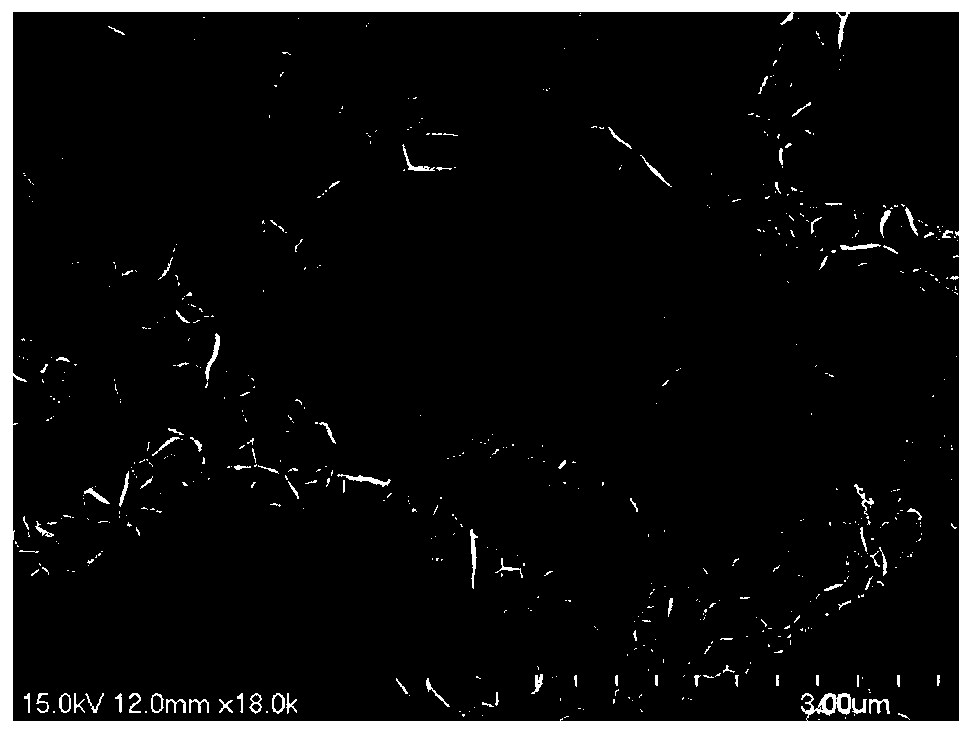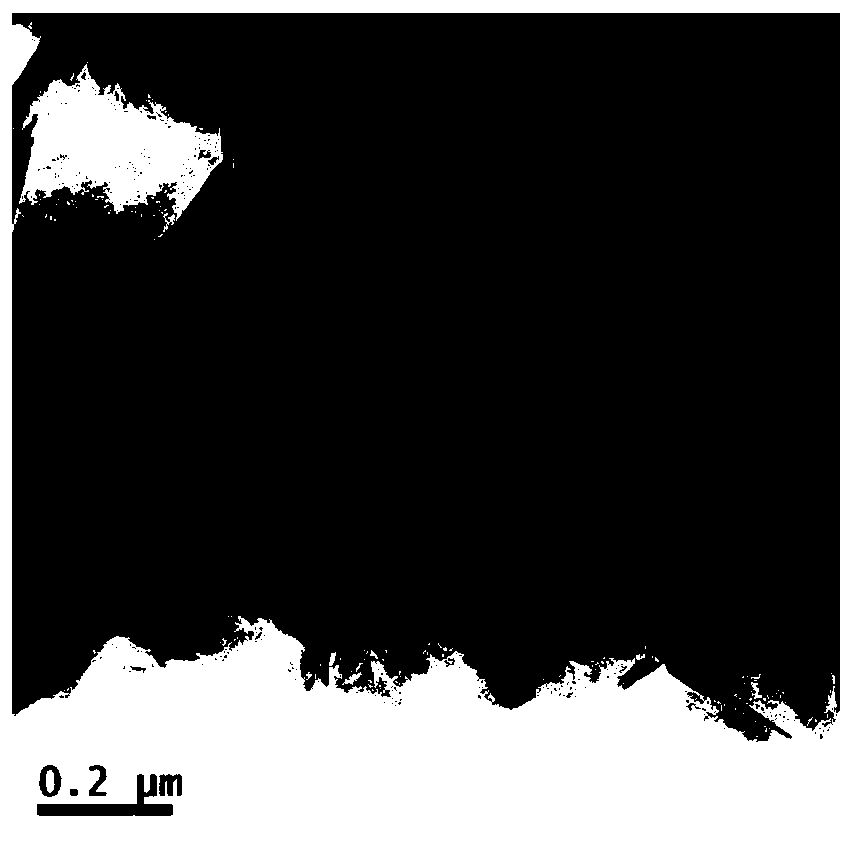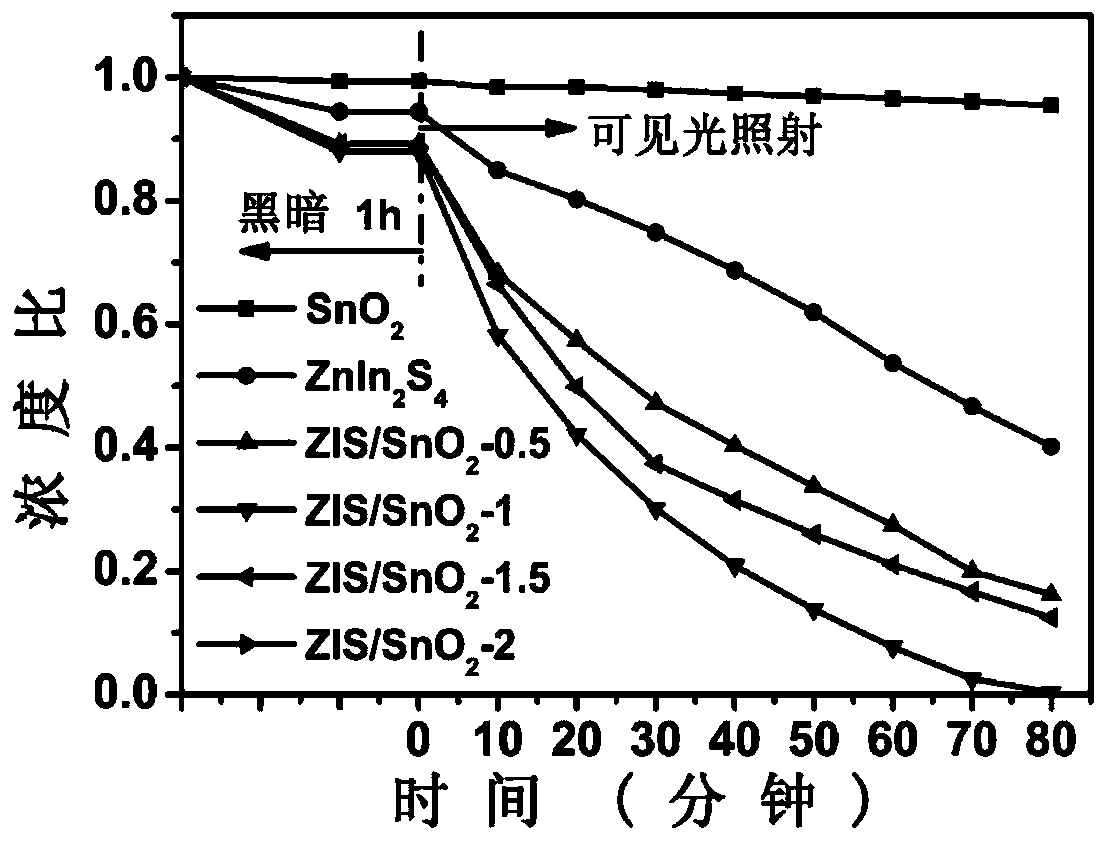Indium zinc sulfide nanosheet/tubular tin oxide heterojunction and preparation method thereof, and application of indium zinc sulfide nanosheet/tubular tin oxide heterojunction in degradation and removal of water pollutants
A technology of indium zinc sulfide and nanosheets, applied in water pollutants, chemical instruments and methods, chemical/physical processes, etc., can solve the problems of low photon yield, easy agglomeration, human and environmental damage, etc., to improve separation efficiency , large specific surface area, simple operation effect
- Summary
- Abstract
- Description
- Claims
- Application Information
AI Technical Summary
Problems solved by technology
Method used
Image
Examples
Embodiment 1
[0035] Pipette 5mL of absolute ethanol and 5mL of N,N'-dimethylformamide sequentially, stir for 5min with magnetic force, and then add 1g of SnCl 2 And stirred for 5 minutes, 1.2g of PVP was added while stirring, and then stirred continuously for 12h to form a uniform transparent solution; subsequently, the transparent solution was used for electrospinning. Among them, the precursor solution was injected with a syringe at 0.2 mm min -1 Feed at a constant rate, connect a DC power supply to provide a high voltage of 15 KV, and place an aluminum foil at a distance of 15 cm from the needle tip to collect SnCI 2 / PVP composite fiber.
[0036] The above SnCI 2 / PVP composite fiber is calcined at a high temperature at 600°C and the heating rate is 2°C / min (room temperature to 600°C). After calcination for 3 hours, it is naturally cooled to room temperature. The calcined product is ground into powder with a mortar to obtain tubular SnO 2 , this is SnO 2 nanotube.
[0037] Add 1 m...
Embodiment 2
[0040] The indium zinc sulfide nanosheet / tubular tin oxide heterojunction of Example 1 was placed in simulated wastewater containing hexavalent chromium (potassium dichromate was used as the chromium source to obtain a hexavalent chromium solution), with a xenon lamp as the light source, and light For a certain period of time, the change curve of the concentration of hexavalent chromium in the water with the light time was measured, so as to evaluate the photocatalytic degradation effect of the composite material on the pollutants in the water under visible light.
[0041] Add 30 mg of indium zinc sulfide nanosheets / tubular tin oxide heterojunction prepared above into 50 mL of hexavalent chromium sewage with a concentration of 50 ppm. Stir for 1 h under dark conditions to make it reach adsorption equilibrium. Subsequently, the xenon lamp light source is turned on, and the catalyst degrades the hexavalent chromium in water under visible light.
[0042] The specific degradation...
Embodiment 3
[0046] Testing of the degradation curves of the InZnS nanosheet / tubular SnO heterojunction when the concentration of the initial hexavalent chromium solution was different. Using the test method of Example 2, the degradation efficiency of hexavalent chromium with different initial concentrations was tested, and it decreased with the increase of the concentration. When the concentration is 10ppm, the degradation rate can reach 100% within 10 minutes, and the effect is very good. When the initial concentration is 20ppm and 30ppm, it can reach 100% within 30 and 60 minutes, respectively, indicating that the composite material is more conducive to the photocatalytic degradation of low concentration of hexavalent chromium. attached Figure 4 It is the degradation curve of the IZnS nanosheet / tubular tin oxide heterojunction when the concentration of the initial hexavalent chromium solution is different.
[0047] When the pH of the initial hexavalent chromium solution (concentratio...
PUM
 Login to View More
Login to View More Abstract
Description
Claims
Application Information
 Login to View More
Login to View More - R&D
- Intellectual Property
- Life Sciences
- Materials
- Tech Scout
- Unparalleled Data Quality
- Higher Quality Content
- 60% Fewer Hallucinations
Browse by: Latest US Patents, China's latest patents, Technical Efficacy Thesaurus, Application Domain, Technology Topic, Popular Technical Reports.
© 2025 PatSnap. All rights reserved.Legal|Privacy policy|Modern Slavery Act Transparency Statement|Sitemap|About US| Contact US: help@patsnap.com



